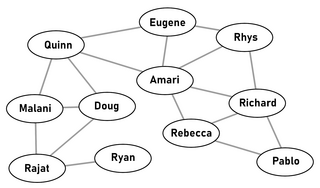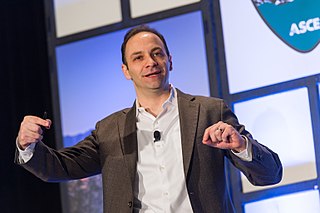Related Research Articles
Time management is the process of planning and exercising conscious control of time spent on specific activities—especially to increase effectiveness, efficiency, and productivity.

Remote work is the practice of working from one's home or another space rather than from an office.

In the social sciences, a social group is defined as two or more people who interact with one another, share similar characteristics, and collectively have a sense of unity. Regardless, social groups come in a myriad of sizes and varieties. For example, a society can be viewed as a large social group. The system of behaviors and psychological processes occurring within a social group or between social groups is known as group dynamics.

Job satisfaction, employee satisfaction or work satisfaction is a measure of workers' contentment with their job, whether they like the job or individual aspects or facets of jobs, such as nature of work or supervision. Job satisfaction can be measured in cognitive (evaluative), affective, and behavioral components. Researchers have also noted that job satisfaction measures vary in the extent to which they measure feelings about the job. or cognitions about the job.

Brainstorming is a creativity technique in which a group of people interact to suggest ideas spontaneously in response to a prompt. Stress is typically placed on the volume and variety of ideas, including ideas that may seem outlandish or "off-the-wall". Ideas are noted down during the activity, but not assessed or critiqued until later. The absence of criticism and assessment is intended to avoid inhibiting participants in their idea production. The term was popularized by advertising executive Alex Faickney Osborn in the classic work Applied Imagination (1953).
Productivity is the efficiency of production of goods or services expressed by some measure. Measurements of productivity are often expressed as a ratio of an aggregate output to a single input or an aggregate input used in a production process, i.e. output per unit of input, typically over a specific period of time. The most common example is the (aggregate) labour productivity measure, one example of which is GDP per worker. There are many different definitions of productivity and the choice among them depends on the purpose of the productivity measurement and data availability. The key source of difference between various productivity measures is also usually related to how the outputs and the inputs are aggregated to obtain such a ratio-type measure of productivity.
The Hawthorne effect is a type of human behavior reactivity in which individuals modify an aspect of their behavior in response to their awareness of being observed. The effect was discovered in the context of research conducted at the Hawthorne Western Electric plant; however, some scholars think the descriptions are fictitious.
In agile principles, timeboxing allocates a maximum unit of time to an activity, called a timebox, within which a planned activity takes place. It is used by agile principles-based project management approaches and for personal time management.

Study skills or study strategies are approaches applied to learning. Study skills are an array of skills which tackle the process of organizing and taking in new information, retaining information, or dealing with assessments. They are discrete techniques that can be learned, usually in a short time, and applied to all or most fields of study. More broadly, any skill which boosts a person's ability to study, retain and recall information which assists in and passing exams can be termed a study skill, and this could include time management and motivational techniques.
Linda Stone, a tech writer and consultant, coined the term continuous partial attention in 1998 to describe a modern adaptive behavior of continuously dividing one's attention. Stone has clarified that continuous partial attention is not the same as multitasking. Where multitasking is driven by a conscious desire to be productive and efficient, CPA is an automatic process motivated only by "a desire to be a live node on the network" or by the willingness to connect and stay connected, scanning and optimizing opportunities, activities and contacts in an effort to not miss anything that is going on.

Workforce productivity is the amount of goods and services that a group of workers produce in a given amount of time. It is one of several types of productivity that economists measure. Workforce productivity, often referred to as labor productivity, is a measure for an organisation or company, a process, an industry, or a country.

Onboarding or organizational socialization is the American term for the mechanism through which new employees acquire the necessary knowledge, skills, and behaviors to become effective organizational members and insiders. In standard English, this is referred to as "induction". In the United States, up to 25% of workers are organizational newcomers engaged in onboarding process.

A habit is a routine of behavior that is repeated regularly and tends to occur subconsciously.
Training and development involve improving the effectiveness of organizations and the individuals and teams within them. Training may be viewed as related to immediate changes in organizational effectiveness via organized instruction, while development is related to the progress of longer-term organizational and employee goals. While training and development technically have differing definitions, the two are oftentimes used interchangeably and/or together. Training and development have historically been topics within adult education and applied psychology but have within the last two decades become closely associated with human resources management, talent management, human resources development, instructional design, human factors, and knowledge management.
Despite a large body of positive psychological research into the relationship between happiness and productivity, happiness at work has traditionally been seen as a potential by-product of positive outcomes at work, rather than a pathway to business success. Happiness in the workplace is usually dependent on the work environment. During the past two decades, maintaining a level of happiness at work has become more significant and relevant due to the intensification of work caused by economic uncertainty and increase in competition. Nowadays, happiness is viewed by a growing number of scholars and senior executives as one of the major sources of positive outcomes in the workplace. In fact, companies with higher than average employee happiness exhibit better financial performance and customer satisfaction. It is thus beneficial for companies to create and maintain positive work environments and leadership that will contribute to the happiness of their employees.

The Pomodoro Technique is a time management method developed by Francesco Cirillo in the late 1980s. It uses a kitchen timer to break work into intervals, typically 25 minutes in length, separated by short breaks. Each interval is known as a pomodoro, from the Italian word for tomato, after the tomato-shaped kitchen timer Cirillo used as a university student.

Liane Margaret Davey is a psychologist, author, public speaker, and business strategist.

Chris Bailey is a Canadian writer and productivity consultant, and the author of The Productivity Project (2016), Hyperfocus (2018) and How to Calm Your Mind (2022).

Ron Friedman is a psychologist and behavior change expert who specializes in human motivation. He is a frequent contributor to the Harvard Business Review, CNN, Fast Company, and Psychology Today, as well as the author of the best-selling non-fiction book The Best Place to Work: The Art and Science of Creating an Extraordinary Workplace.
Timeblocking or time blocking is a productivity technique for personal time management where a period of time—typically a day or week—is divided into smaller segments or blocks for specific tasks or to-dos. It integrates the function of a calendar with that of a to-do list. It is a kind of scheduling.
References
- 1 2 3 "How the Most Productive People Schedule Their Day". The Muse. 31 July 2014. Retrieved 10 June 2021.
- ↑ "Take a Break - The 52/17 Rule" . Retrieved 24 March 2023.
- ↑ "How (And Why) To Use The 52/17 Rule To Boost Productivity". 17 January 2023. Retrieved 24 March 2023.
- ↑ "Why Taking A Bunch Of Breaks Wasn't As Great As We Expected" . Retrieved 24 March 2023.
- ↑ Trougakos, J. P.; Hideg, I. (2015). "Working in episodes: A field study of breaks and focused work". Journal of Applied Psychology. 100 (6): 1643–1655. doi:10.1037/a0039004. PMID 25798720.
- ↑ Hunter, E. M.; Chaskalson, M. (2017). "When it's mindfulness training and when it's cognitive-behavioral therapy: An exploratory study of framing in a workplace stress reduction intervention". Journal of Occupational Health Psychology. 22 (2): 153–167. doi:10.1037/ocp0000026. PMID 27054501. S2CID 21246293.
- ↑ Rosenbaum, D. A.; Heidary, R. (2014). "The perilous lure of the multitasking myth". Journal of Experimental Psychology: General. 143 (2): 731–738. doi:10.1037/a0035236. PMID 24364745.
- ↑ Amabile, T. M. (1996). "Assessing the work environment for creativity". Academy of Management Journal. 39 (5): 1154–1184. doi:10.5465/256995 (inactive 19 April 2024). JSTOR 256995.
{{cite journal}}: CS1 maint: DOI inactive as of April 2024 (link) - ↑ "Secret of the Most Productive People - Breaking | DeskTime Blog". 14 May 2018.
- ↑ Stillman, Jessica (18 August 2014). "The Magic Numbers for Maximum Productivity: 52 and 17". Inc.com.
- ↑ Patkar, Mihir (7 August 2014). "52-Minute Work, 17-Minute Break is the Ideal Productivity Schedule". Lifehacker.
- ↑ Thompson, Derek (17 September 2014). "A Formula for Perfect Productivity: Work for 52 Minutes, Break for 17". The Atlantic.
- ↑ Evans, Lisa (15 September 2014). "The Exact Amount Of Time You Should Work Every Day". Fast Company.
- ↑ "What the most productive workers have in common". The Washington Post. Retrieved 10 June 2021.
- ↑ "5217 - time management for increased productivity - Apps on Google Play".
- ↑ "52-17 Productivity Improver". 52-17.com. Archived from the original on 11 February 2023. Retrieved 10 June 2021.
- ↑ "The 52/17 productivity rule UPDATED (It's all different now!)". YouTube .
- ↑ https://www.fastcompany.com/90668336/the-pandemic-may-have-affected-how-the-most-productive-people-take-breaks
- ↑ "How (And Why) To Use The 52/17 Rule To Boost Productivity". 13 April 2021.
- ↑ Johnson, Matt. "How to Stay Productive While Staying Sane | Taskable Blog". taskablehq.com. Retrieved 23 September 2021.